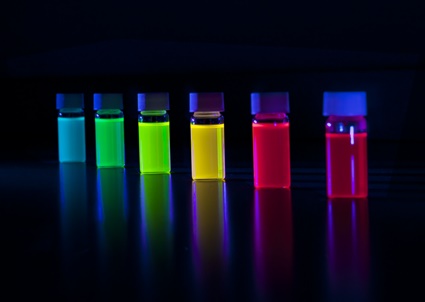The Quantum Yield of Quantum Dots
The optoelectronic behavior of quantum dots is strongly size- and chemistry-dependent. Larger nanocrystals tend to emit light of longer wavelengths when excited by incident photons. It naturally follows that smaller quantum dots emit light of shorter wavelengths. The efficiency of this process is determined as a ratio of the difference between light absorbed and light emitted, which is known as the quantum yield.
Quantum yield (Φ) determines a material’s photoemissive efficiency up to a maximum value of Φ1 (100%), also described as unity. Unity is practically unattainable given the non-radiative processes that occur within quantum dots when photons are absorbed. However, advanced technologies are increasingly beginning to display quantum yields approaching 100%, which could prove pivotal in the global push towards sustainability and energy efficiency.
Comparing Quantum Yields
 Quantum dots are at the forefront of electronics innovation, challenging inefficient systems in display and organic photovoltaic (OPV) applications. Their enhanced quantum efficiencies are largely based on the crystal size distribution of thin-film structures. Broader distributions widen the band gap and enable optimal absorption and emission characteristics across as much of the wavelength spectrum as possible. Size dependence significantly limits the potential quantum yield of quantum dots, however.
Quantum dots are at the forefront of electronics innovation, challenging inefficient systems in display and organic photovoltaic (OPV) applications. Their enhanced quantum efficiencies are largely based on the crystal size distribution of thin-film structures. Broader distributions widen the band gap and enable optimal absorption and emission characteristics across as much of the wavelength spectrum as possible. Size dependence significantly limits the potential quantum yield of quantum dots, however.
This is true of conventional quantum dot chemical compositions such as cadmium selenide (CdSe) and indium phosphide (InP). These must be encased in one or more inorganic shells to achieve a quantum yield suitable for electronic applications. It is possible to achieve quantum efficiencies approaching 90% with CdSe or InP technology, but the process of synthesizing single or multishell quantum dots to tightly-defined particle size distributions is costly and inefficient.
The emissive properties of metal halide perovskites, however, are largely dependent on their novel chemical arrangements. This enables fine-tuning of the emission wavelengths irrespective of crystal size, representing a simpler and more cost-efficient production process. Perovskite quantum dots can be synthesized in a single step process, requiring no inorganic shell for stability or quantum yield. This yields the highest possible quantum yield for liquid crystal display (LCD) applications of almost 100% and provides class-leading peak brightness levels for QD-LCD devices.
Metal halide quantum dots outperform CdSe alternatives in absorbance per gram by a factor of three times and InP crystals by ten times.
Quantum Dots from Avantama
Avantama’s innovative quantum dots have revolutionized R&D into novel LCD matrices with the best-in-class quantum yields. This has changed the dynamic between established technology and organic light-emitting diodes (OLEDs) which are widely considered the future of display technologies. Quantum dots have challenged that established belief and have introduced significant change into the display market.
If you would like any more information about the performance levels of our metal halide products, please do not hesitate to contact us.